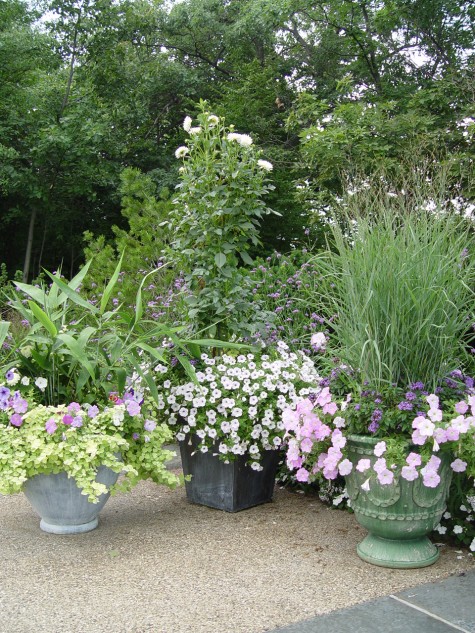 What could be better than a giant pot stuffed to overflowing with nicotiana? OK, probably plenty of things, but no doubt I am a big fan of the nicotianas. There are a number of ornamental tobaccos suitable for cultivation in our area. The species nicotiana alata pictured above grows strongly to 30″ or better. It has a loose, rangy, and unstructured habit of growth. Sporting clusters of big leaves at the base, the flowers appear all along thin soft stems. They are indeterminate bloomers; a stalk will continue to elongate and produce flowers for months. Once a stalk blooms out, and starts setting seed, I trim it back.
What could be better than a giant pot stuffed to overflowing with nicotiana? OK, probably plenty of things, but no doubt I am a big fan of the nicotianas. There are a number of ornamental tobaccos suitable for cultivation in our area. The species nicotiana alata pictured above grows strongly to 30″ or better. It has a loose, rangy, and unstructured habit of growth. Sporting clusters of big leaves at the base, the flowers appear all along thin soft stems. They are indeterminate bloomers; a stalk will continue to elongate and produce flowers for months. Once a stalk blooms out, and starts setting seed, I trim it back. 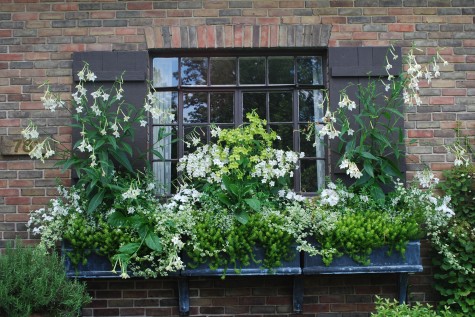
The species nicotiana alata is very fragrant in the evening, but my favorite part is the simple star shaped flowers. Individually, they have the same impact common to any simple flower. I favor hellebores, single roses such as Sally Holmes, mandevilleas and Japaense anemones for this reason. Single flowers are swell. The individual florets make a graceful mass; I like the looks of the from the sides and the back, as much as from the front. In the box pictured above, Nicotiana Alata white, Nicotiana alata lime, and Nicotiana Perfume white-the shortest of the group. 
Nicotiana alata lime is a brilliant lime. The petals are thin eough to permit light to shine through. Their color makes every other color look good, and they are equally as effective if a combination of greens is your idea of beautiful. I always have them close by my deck, as hummingbirds visit regularly. I would much rather grow nicotianas and fuchsias, than deal with a hummingbird feeder.
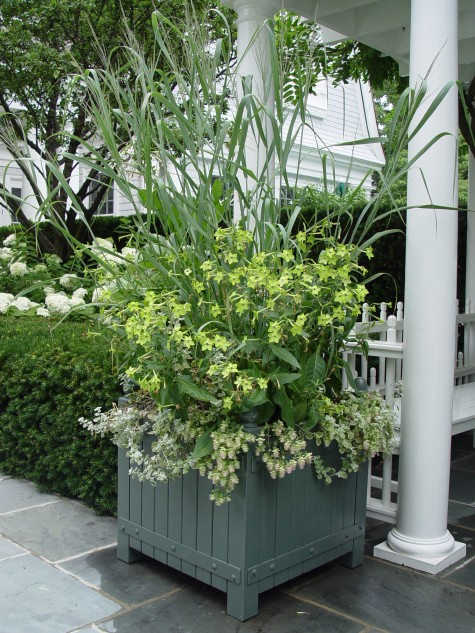 A pairing with Panicum Virgatum Dallas Blues makes that grass all the more icy blue in appearance. Grasses can be difficult to do well in a container, as they are stiff, or awkwardly floppy. Nicotiana makes for a graceful ruff here. They are not without their problems, however. The sticky soft succulent stems are a magnet for aphids. Their giant basil leaves sometimes need pruning back when they threaten to smother something else growing at ground level.
A pairing with Panicum Virgatum Dallas Blues makes that grass all the more icy blue in appearance. Grasses can be difficult to do well in a container, as they are stiff, or awkwardly floppy. Nicotiana makes for a graceful ruff here. They are not without their problems, however. The sticky soft succulent stems are a magnet for aphids. Their giant basil leaves sometimes need pruning back when they threaten to smother something else growing at ground level.
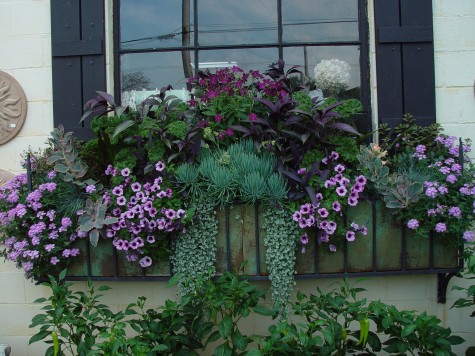
Some nicotiana hybrids are short, stodgy and airless in appearance; I do not grow the Avalon series for this reason. Of all the shorter growing hybrids, the Perfume series seems the most graceful. Perfume purple is a most unusual and intense red purple; true to its name, the smell is divine.
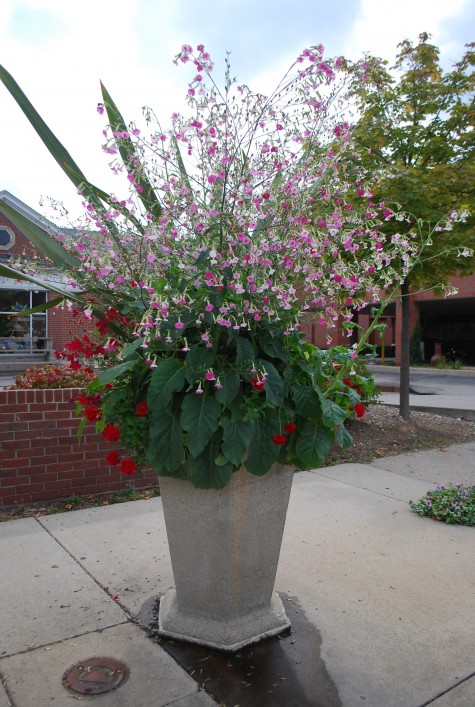 But by far and away my favorite is Nicotiana Mutabilis. It grows tall, and billows out over any edge with a cloud of small flowers that dance in the slightest breeze. Can you tell I like it? The flowers range from white to cream to pale pink to rose pink. This big thing requires secure staking from the beginning. It will pick up speed, and send out new growth from the base of the plant as the night temperatures start to cool.
But by far and away my favorite is Nicotiana Mutabilis. It grows tall, and billows out over any edge with a cloud of small flowers that dance in the slightest breeze. Can you tell I like it? The flowers range from white to cream to pale pink to rose pink. This big thing requires secure staking from the beginning. It will pick up speed, and send out new growth from the base of the plant as the night temperatures start to cool.
 They are a nuisance to keep deadheaded-I don’t fuss so much with that. Its hard to spot which stems need headling back, and every part of the plant is sticky. This seems a fairly minor problem to me; a well grow stand of mutabilis is enchanting.
They are a nuisance to keep deadheaded-I don’t fuss so much with that. Its hard to spot which stems need headling back, and every part of the plant is sticky. This seems a fairly minor problem to me; a well grow stand of mutabilis is enchanting.
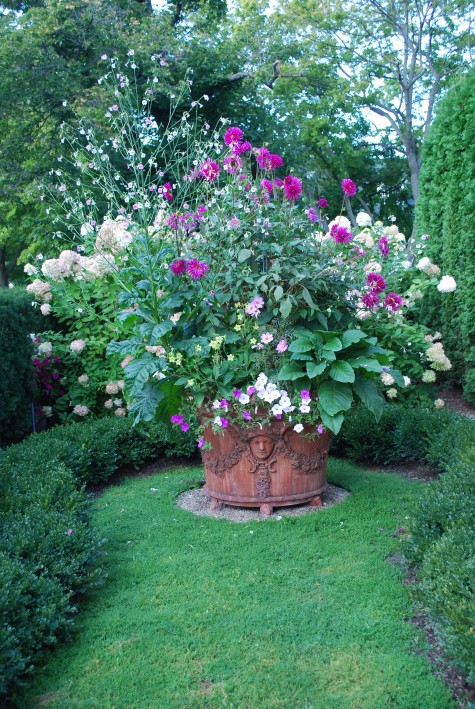 You can see the new growth pushing from the base of this pot on both sides; all of this came on strong in September, and will continue until a hard freeze. They also seem much more aphid-resistant than other nicotianas.
You can see the new growth pushing from the base of this pot on both sides; all of this came on strong in September, and will continue until a hard freeze. They also seem much more aphid-resistant than other nicotianas.
 The individual flowers are so small and so delicate; the overall picture is delightfully meadow like. All of these nicotianas are a staple of my summer garden.
The individual flowers are so small and so delicate; the overall picture is delightfully meadow like. All of these nicotianas are a staple of my summer garden.
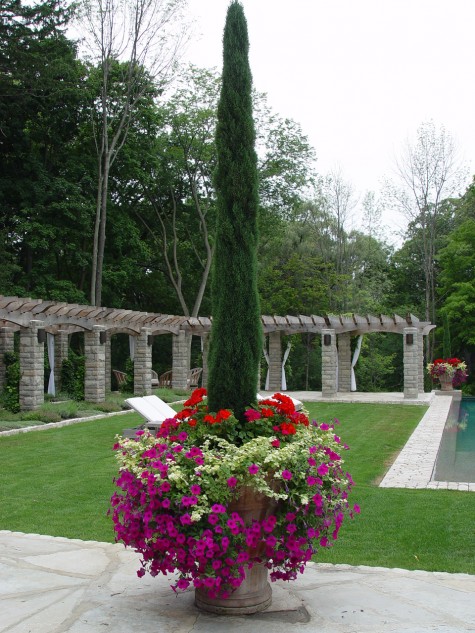 On my top ten list of frequently asked questions, the culture of evergreens in pots ranks right up there. In theory it sounds great. You invest in an evergreen which will provide you with a center of interest that looks great no matter the season. Perhaps there will be room on the edges for a few seasonal annuals. The work and expense up front is considerably more than planting smaller and less expensive plants, but then you are done. Redoing one’s pots with new plants every new season no doubt is a lot of work and expense. But as with everything connected to growing a garden, one is rarely “done”. The Italian cypress in the pot pictured above is not hardy in Michigan, nor can one leave a terra cotta pot such as this one outdoors during the winter. The cypress has to be wintered in a greenhouse cold storage area, and replanted every spring. The pot is put away. There is time and trouble hauling it back to the greenhouse in late fall.
On my top ten list of frequently asked questions, the culture of evergreens in pots ranks right up there. In theory it sounds great. You invest in an evergreen which will provide you with a center of interest that looks great no matter the season. Perhaps there will be room on the edges for a few seasonal annuals. The work and expense up front is considerably more than planting smaller and less expensive plants, but then you are done. Redoing one’s pots with new plants every new season no doubt is a lot of work and expense. But as with everything connected to growing a garden, one is rarely “done”. The Italian cypress in the pot pictured above is not hardy in Michigan, nor can one leave a terra cotta pot such as this one outdoors during the winter. The cypress has to be wintered in a greenhouse cold storage area, and replanted every spring. The pot is put away. There is time and trouble hauling it back to the greenhouse in late fall. This 25 year old rosemary has spent 25 winters in a glass house. It is an evergreen-should you live in Greece or Italy, or California. Michigan winters are fiercely cold. However unfair it seems, rosemary is just not hardy here. In return for the extraordinary pleasure of owning an old rosemary such as this one, my client is willing to weather what it takes to keep it alive and healthy.
This 25 year old rosemary has spent 25 winters in a glass house. It is an evergreen-should you live in Greece or Italy, or California. Michigan winters are fiercely cold. However unfair it seems, rosemary is just not hardy here. In return for the extraordinary pleasure of owning an old rosemary such as this one, my client is willing to weather what it takes to keep it alive and healthy.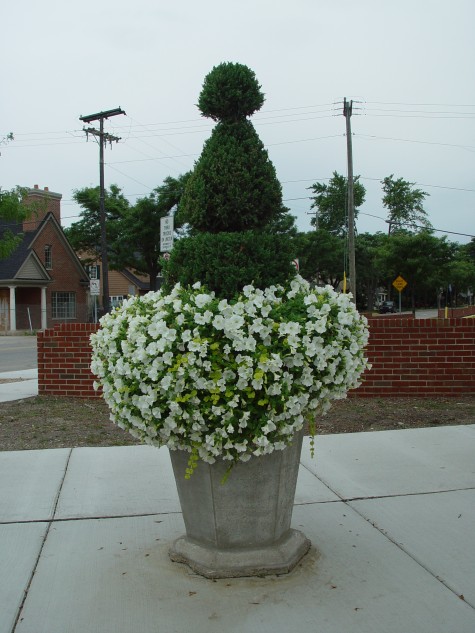
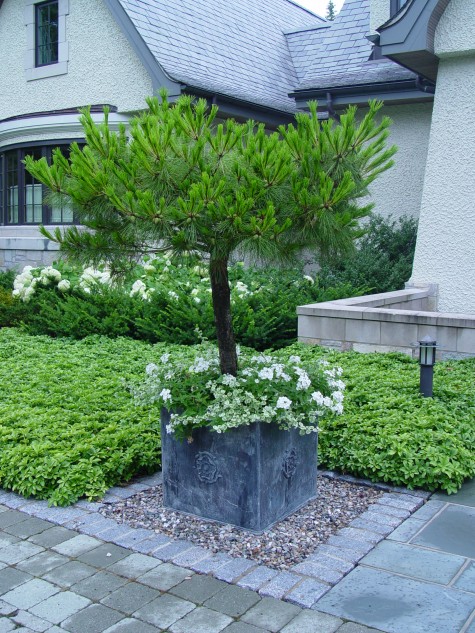 Mugho pines, both the shrubby and the topiary forms, have the reputation of good survivability in pots. Critical to that survival is proper watering. Should you quit watering this evergreen when your geraniums go down from frost, you are almost certain to loose it. Judicious watering right up until the soil ball is frozen solid is a must. If this evergreen were to unfreeze in a January thaw, a watering might be in order. When the soil thaws in the spring, the watering should be resumed-even if this is long before you plant your other pots. What evergreens in containers require is not for the faint of heart.
Mugho pines, both the shrubby and the topiary forms, have the reputation of good survivability in pots. Critical to that survival is proper watering. Should you quit watering this evergreen when your geraniums go down from frost, you are almost certain to loose it. Judicious watering right up until the soil ball is frozen solid is a must. If this evergreen were to unfreeze in a January thaw, a watering might be in order. When the soil thaws in the spring, the watering should be resumed-even if this is long before you plant your other pots. What evergreens in containers require is not for the faint of heart.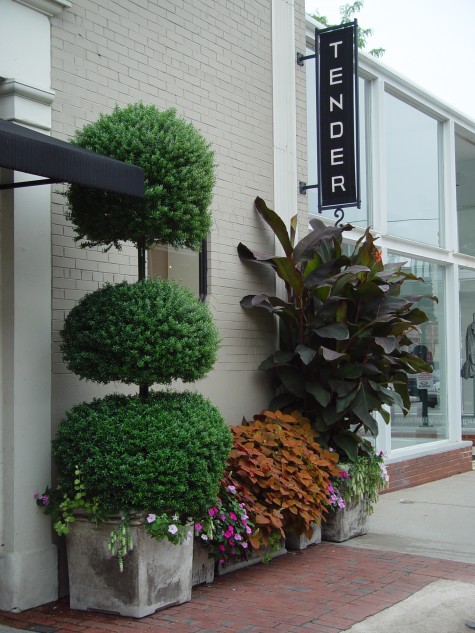 This grand old myrtle topiary was beautifully maintained, for 11 summers. The 12th winter in the greenhouse, a furnace went out, and it froze. It has been in the greenhouse for the past two years; we are trying to coax it back to health. Owning plants like this is a big committment with little in the way of any guarantee. Just because you have provided next to perfect care for a long time does not mean you cannot loose it. Evergreens in containers are for gardeners who relish risk.
This grand old myrtle topiary was beautifully maintained, for 11 summers. The 12th winter in the greenhouse, a furnace went out, and it froze. It has been in the greenhouse for the past two years; we are trying to coax it back to health. Owning plants like this is a big committment with little in the way of any guarantee. Just because you have provided next to perfect care for a long time does not mean you cannot loose it. Evergreens in containers are for gardeners who relish risk.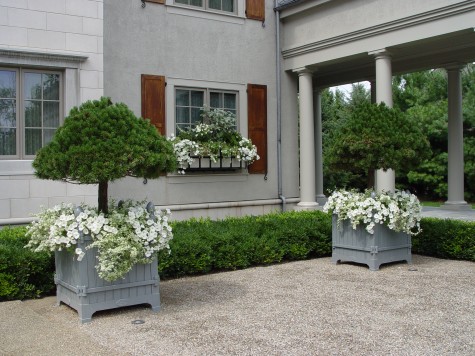 These mugho pines on standard have lived in these orangery boxes for 6 years. At some point, they should be taken out, root pruned, and reset in fresh soil. They will most certainly decline without this maintenance. No plant stays the same, just because its container stays the same. Plants will prosper and grow, or sulk and decline-one or the other.
These mugho pines on standard have lived in these orangery boxes for 6 years. At some point, they should be taken out, root pruned, and reset in fresh soil. They will most certainly decline without this maintenance. No plant stays the same, just because its container stays the same. Plants will prosper and grow, or sulk and decline-one or the other.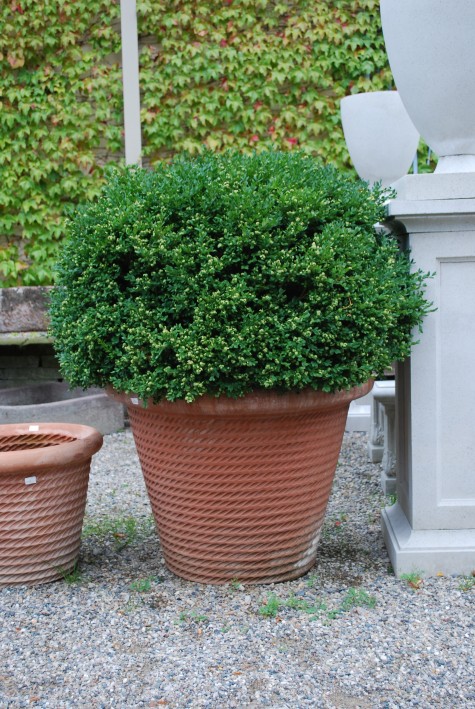 Boxwood is a good choice for a container. As this French terra cotta pot cannot be left out, I wheel this entire assembly into the garage for the winter. This species, Buxus Microphylla, is very tough; my hedge on the southside of my building never winter burns. In the same spirit, it tolerates a mostly dark and unheated garage from November until March. At the first sign of moderating temperatures, I take it back outside. A garage can get too warm for holding plants dormant long before the outside temperatures moderate.
Boxwood is a good choice for a container. As this French terra cotta pot cannot be left out, I wheel this entire assembly into the garage for the winter. This species, Buxus Microphylla, is very tough; my hedge on the southside of my building never winter burns. In the same spirit, it tolerates a mostly dark and unheated garage from November until March. At the first sign of moderating temperatures, I take it back outside. A garage can get too warm for holding plants dormant long before the outside temperatures moderate.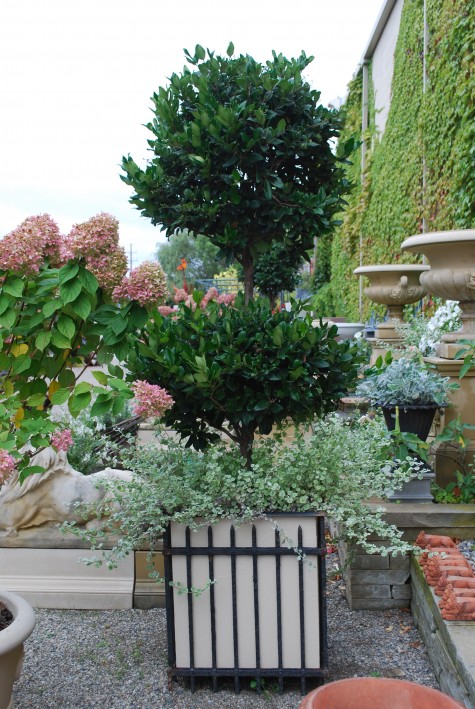 Waxleaf privets are an aristocratic cousin of our hardy privet. The large leaves are lustrous and juicy looking. They are hardy in zone 7, so they can be wintered in an indoor spot without much in the way of heat. They grow slowly, and are available in big sizes; there is demand for the topiary forms from gardeners in more temperate regions. They take well to pruning and shaping.
Waxleaf privets are an aristocratic cousin of our hardy privet. The large leaves are lustrous and juicy looking. They are hardy in zone 7, so they can be wintered in an indoor spot without much in the way of heat. They grow slowly, and are available in big sizes; there is demand for the topiary forms from gardeners in more temperate regions. They take well to pruning and shaping.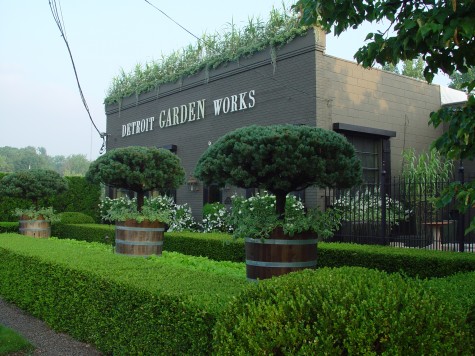
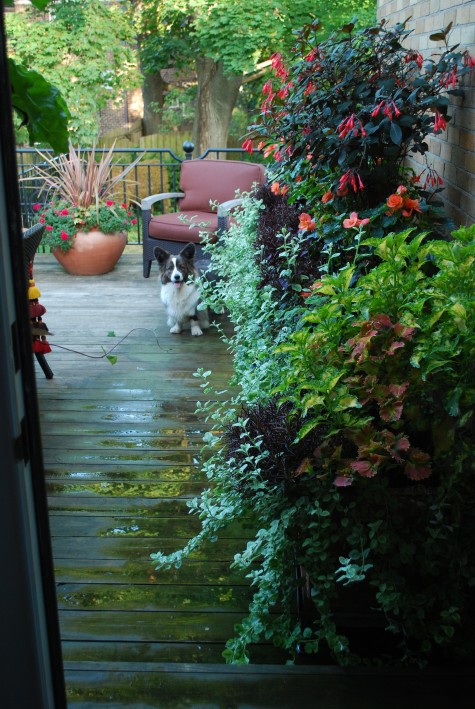 There are plenty of evenings during the course of the summer that I don’t have dinner outdoors-It could be too hot, or too buggy, or I might just be too tired to take everything outside only to have to bring it back in again. I also believe I have no end of summer days to choose from, but end they do. Yesterday it was benignly summer; today the weather is is cold and blustering towards fall. I know when I start coming to work in the dark, the close of summer can’t be far behind. As many nights as possible now, we all have dinner outdoors.
There are plenty of evenings during the course of the summer that I don’t have dinner outdoors-It could be too hot, or too buggy, or I might just be too tired to take everything outside only to have to bring it back in again. I also believe I have no end of summer days to choose from, but end they do. Yesterday it was benignly summer; today the weather is is cold and blustering towards fall. I know when I start coming to work in the dark, the close of summer can’t be far behind. As many nights as possible now, we all have dinner outdoors.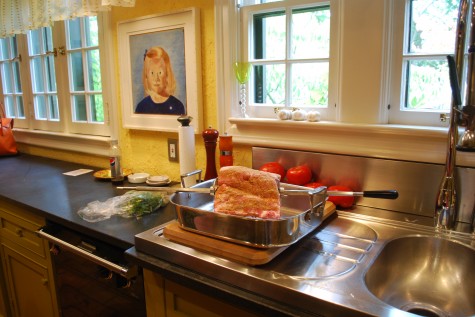 Buck does all the cooking-lucky for me. My idea of dinner on my own consists of cans of black olives, chick peas, tinned tuna, slabs of good cheese and chips of some sort. I am also likely to eat this over the sink; who would make the effort to set a table, and then wash dishes over this? On my own, I don’t cook, I survive. I take care of what needs doing in support of the cooking, and I am happy with this arrangement. Buck decides to do a roast on the grill for our close of summer dinner.
Buck does all the cooking-lucky for me. My idea of dinner on my own consists of cans of black olives, chick peas, tinned tuna, slabs of good cheese and chips of some sort. I am also likely to eat this over the sink; who would make the effort to set a table, and then wash dishes over this? On my own, I don’t cook, I survive. I take care of what needs doing in support of the cooking, and I am happy with this arrangement. Buck decides to do a roast on the grill for our close of summer dinner. One doesn’t need to cook in order to appreciate great china. I could get out of hand easily; there are plenty of great china patterns out there. I get by with 2 sets; one is on permanent view on a shelf just sixteen inches below the ceiling in my kitchen. I take it down once a year to wash it; it’s out of the way, but always there for me to see. I built a painted Welsh cabinet for my other set. It took a long time to accumulate a service for eight, and even more time for the platters, breadbaskets and such. It was worth the wait; it is as much pleasure to look at as it is functional.
One doesn’t need to cook in order to appreciate great china. I could get out of hand easily; there are plenty of great china patterns out there. I get by with 2 sets; one is on permanent view on a shelf just sixteen inches below the ceiling in my kitchen. I take it down once a year to wash it; it’s out of the way, but always there for me to see. I built a painted Welsh cabinet for my other set. It took a long time to accumulate a service for eight, and even more time for the platters, breadbaskets and such. It was worth the wait; it is as much pleasure to look at as it is functional. 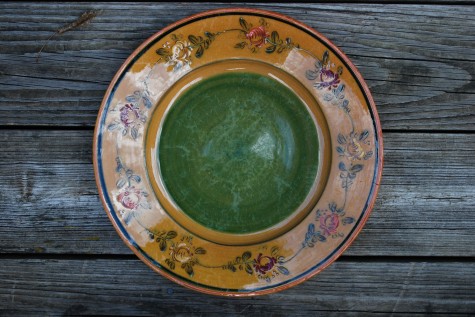 This French china is handmade by Veronique Pichon. None of her pieces have that perfect shape and repetition of design characteristic of machine made china. It is heavy, chunky and chip resistant-a good choice for china used outdoors. The green and ochre ground, with handpainted pink and rose flowers, looks good set in my garden.
This French china is handmade by Veronique Pichon. None of her pieces have that perfect shape and repetition of design characteristic of machine made china. It is heavy, chunky and chip resistant-a good choice for china used outdoors. The green and ochre ground, with handpainted pink and rose flowers, looks good set in my garden.  My stainless flatware has olivewood handles set in pewter ferrules. The color variation in the wood has everything to do with the dishwasher. The handles of the utensils I use every day have gone dark. As we only have dessert once in a great while, the olivewood is still pale colored. As much as I like limestone steps that are worn from all the walking, I like things that look like they have been used.
My stainless flatware has olivewood handles set in pewter ferrules. The color variation in the wood has everything to do with the dishwasher. The handles of the utensils I use every day have gone dark. As we only have dessert once in a great while, the olivewood is still pale colored. As much as I like limestone steps that are worn from all the walking, I like things that look like they have been used.  Of course we need flowers. The boltonia, Japanese anemone and asparagus from the garden look good in a McCoy ceramic vase from the forties. Cut flowers last such a long time outdoors-it must be the light. Cut flowers have a decidedly different feeling than flowers planted in the ground, as they are arranged.
Of course we need flowers. The boltonia, Japanese anemone and asparagus from the garden look good in a McCoy ceramic vase from the forties. Cut flowers last such a long time outdoors-it must be the light. Cut flowers have a decidedly different feeling than flowers planted in the ground, as they are arranged.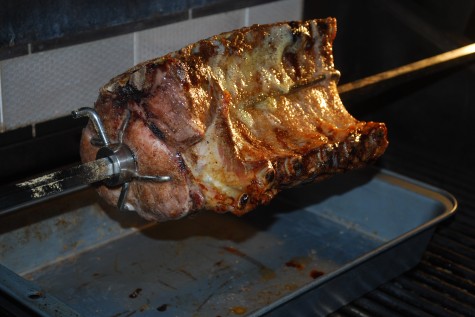 Buck loves to cook, and he says the rotisserie on the grill makes the work of it easy. If you are not a fan of cleaning the oven, cleaning a drip pan takes a lot less time and effort. The big design idea here-a terrace which is close to the kitchen makes it as easy to dine outside as it is to picnic-maybe easier. Good tools make quick work of the prep and cleanup. Sturdy china doesn’t mind being stacked for the trip back to the kitchen.
Buck loves to cook, and he says the rotisserie on the grill makes the work of it easy. If you are not a fan of cleaning the oven, cleaning a drip pan takes a lot less time and effort. The big design idea here-a terrace which is close to the kitchen makes it as easy to dine outside as it is to picnic-maybe easier. Good tools make quick work of the prep and cleanup. Sturdy china doesn’t mind being stacked for the trip back to the kitchen.  I like fresh food simply prepared-probably as I have been exposed to how good that can be. Food for me is not the main attraction-it is the place, the friends, the season and the weather and the food all rolled together that makes for a great time.
I like fresh food simply prepared-probably as I have been exposed to how good that can be. Food for me is not the main attraction-it is the place, the friends, the season and the weather and the food all rolled together that makes for a great time. 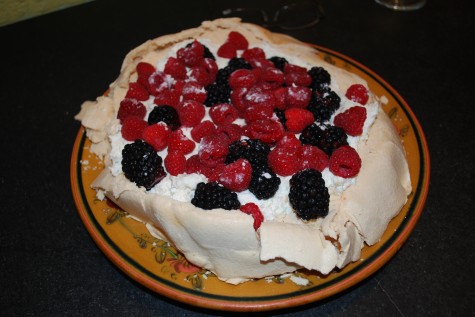 A pavlova for dessert-definitely out of the ordinary. A shell formed from a baked meringue is loaded with whipped cream and mascarpone cheese; this melt in your moth extravaganza is topped with a mix of the fruit of the season. Invented in New Zealand in honor of a visit by Anna Pavlova, it is my favorite summer dessert.
A pavlova for dessert-definitely out of the ordinary. A shell formed from a baked meringue is loaded with whipped cream and mascarpone cheese; this melt in your moth extravaganza is topped with a mix of the fruit of the season. Invented in New Zealand in honor of a visit by Anna Pavlova, it is my favorite summer dessert. 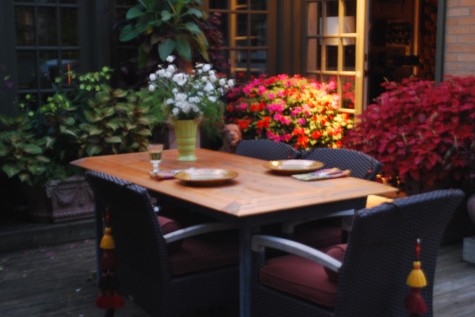
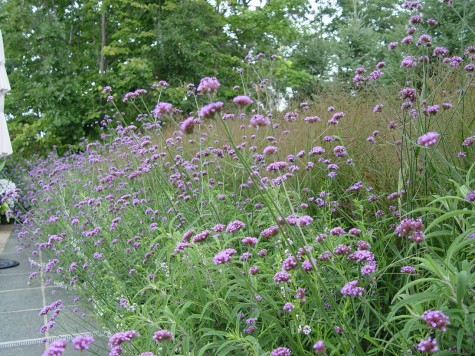
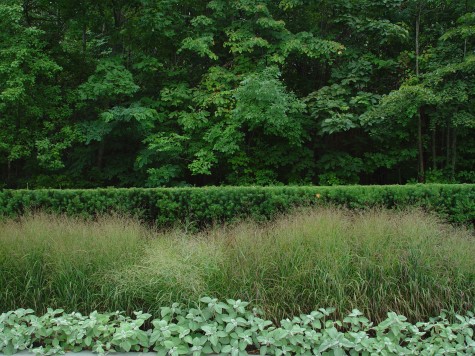 I am a fan of ornamental grasses-espcially the thin bladed wiry types that stand up well. This hedge of panicum virgatum is a welcome textural change from the dark stiffly formal yew hedge pictured above. When I add verbena bonariensis in front of this grass, something good starts cooking. It might very well be that orangy cast typical of a panic grass setting seed; the lavender verbena flowers seem more intensely lavender.
I am a fan of ornamental grasses-espcially the thin bladed wiry types that stand up well. This hedge of panicum virgatum is a welcome textural change from the dark stiffly formal yew hedge pictured above. When I add verbena bonariensis in front of this grass, something good starts cooking. It might very well be that orangy cast typical of a panic grass setting seed; the lavender verbena flowers seem more intensely lavender.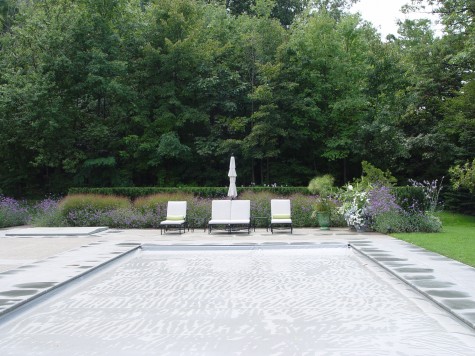 This simple and soft flower/grass hedge transforms a strictly formal evergreen garden for the summer months. Running the entire length of the landscape on both ends of the pool, its cloud-like appearance is on one hand in stark contrast to the modern chaises, and on the other, friendly in feeling and color to the loosely planted pots.
This simple and soft flower/grass hedge transforms a strictly formal evergreen garden for the summer months. Running the entire length of the landscape on both ends of the pool, its cloud-like appearance is on one hand in stark contrast to the modern chaises, and on the other, friendly in feeling and color to the loosely planted pots.  Alyssum, lavender, silver posie thyme and tricolor sage make a pale ruff around a blue foliaged escheveria in this old stone box. The peach flowers of the echeveria-a bonus. Though delicate in appearance, these plants are drought and frost resistant. It interests me that something so fragile in appearance can withstand hit-and-miss care. Plant combinations such as this one are as foolproof as they come. Deadhead the lavender, and shear the alyssum once in a while-that’s all. Their only enemy-too much water.
Alyssum, lavender, silver posie thyme and tricolor sage make a pale ruff around a blue foliaged escheveria in this old stone box. The peach flowers of the echeveria-a bonus. Though delicate in appearance, these plants are drought and frost resistant. It interests me that something so fragile in appearance can withstand hit-and-miss care. Plant combinations such as this one are as foolproof as they come. Deadhead the lavender, and shear the alyssum once in a while-that’s all. Their only enemy-too much water.  jjThere are other grey foliaged plants that are just as rugged. Though I am not so fond of the cut-leaf annual dusty miller, the paddle shaped leaves of cirrus dusty miller I find very appealing. The texture of simple shaped leaves, repeated in a smaller version with the silver helicrysum, is a great contrast to the needle foliaged icicle plant. The saucy and ferny foliaged plant in the center-a silver centaurea. Only the white nicotiana in this basket would fuss if you forgot to water.
jjThere are other grey foliaged plants that are just as rugged. Though I am not so fond of the cut-leaf annual dusty miller, the paddle shaped leaves of cirrus dusty miller I find very appealing. The texture of simple shaped leaves, repeated in a smaller version with the silver helicrysum, is a great contrast to the needle foliaged icicle plant. The saucy and ferny foliaged plant in the center-a silver centaurea. Only the white nicotiana in this basket would fuss if you forgot to water. The trailing plant front and center in this pot-showy oregano. Though they show poorly in pots early on, they fill out beautifully. The papery bracts are the palest green, lavender and peach.
The trailing plant front and center in this pot-showy oregano. Though they show poorly in pots early on, they fill out beautifully. The papery bracts are the palest green, lavender and peach. 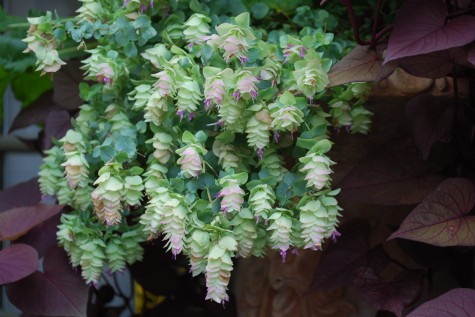
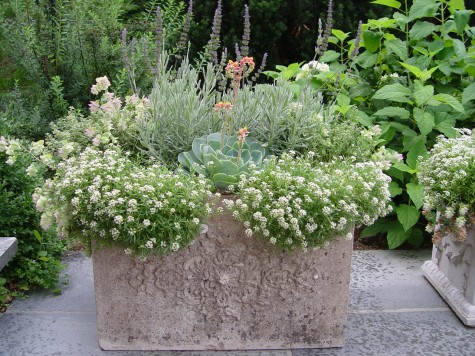 These plants are fairly diminuitive growers, so not so much grooming and shaping is necessary. Though it is late summer, no plant is overgrown, or threatening the well-being of a neighbor. This pot has shown well the better part of four months.
These plants are fairly diminuitive growers, so not so much grooming and shaping is necessary. Though it is late summer, no plant is overgrown, or threatening the well-being of a neighbor. This pot has shown well the better part of four months.